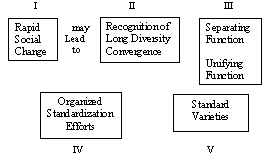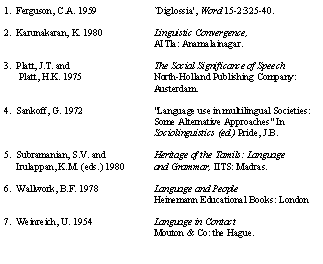It
is said that linguistic convergence takes place due to the processes of
pidginisation, creolisation, realignment or a combination, of all these.
Sometimes, the degree of convergence is attributed to the influence and
impact of one particular contacting language or more languages in use, in the
area concerned. Depending upon the
degree of convergence, we get a new variety of language, a new style, a mixed
variety, etc. and all such varieties have different social significance in use.
For example, some varieties have restricted use; some other varieties
become native tongues and attain the status of mother tongue and so on.
As
far as the diglossic situation is concerned, it is slightly different, that is,
to use of non-native usages, the practice of nativisation of linguistic
features, realignment of linguistic features in standard norms and the question
of efficiency of the usages in communication are some of the important factors
responsible for linguistic convergence. Apart
from these factors, there are some social factors like the attitude of the
people towards the use of certain usages, varieties, styles, etc., the social
significance of some of the usages and so on.
As
per the definition of diglossia given by
The
diglossic situation that exists to-day, presents several problems both in
language use and in language development. The
dichotomy of the varieties as high and low, though mutually exclusive in
language use, there are evidences which show a kind of fluctuation and
overlapping from one variety to the other with regard to some of the social
functions. The situation that is in
practice in the case of Tamil language demonstrates this process.
So, it is very difficult to restrict the boundary between the high and
the low varieties of a language at least in some of the clear cut cases of
language case.
The
maintenance of language varieties is one of the important issues in the case of
diglossic situation. There are
different standards like colloquial standard, literary standard, high literary
standard etc. Functionally, the standards are distinct to a greater extent in
several diglossic languages, but there seems to be a shift to a certain extent
in at least some of the diglossic languages like Tamil.
For example, two or more functions share certain features from both the
varieties. This kind of use leads to
linguistic diffusion which eventually brings into effect some kind of
commonality in the name of convergence. This
is one of the reasons why we have to think of the study of convergence and its
significance in language use even in the case of diglossic situations.
If one goes through the language of mass media, modern literature, etc.
he or she can very well understand the situation.
Tamil,
which aptly suits the definition of diglossia as given by Forguson has two
varieties viz. the spoken (low) variety and the literary (high) variety.
In the context of this diglossic situation we find convergence taking
place. As in the case
of bilingual convergence, it is possible to predict the nature and
direction of convergence, something is possible in the case of convergence in
the diglossic situation also.
When
convergence takes place in diglossic situations, it mainly comes into practice
through the spoken variety. Since
the per centage of literacy in
It
is obvious, therefore, that those people with the least amount of formal
education, usually those from the lower socio-economic classes, will be
relatively unfamiliar with high variety, particularly in so far as some of the
`normal' functions of high variety (eg. For poetry or political speeches) are
concerned because they are not of close or immediate concern to many such
people. The extent to which the high
variety is used in education, they may be at a disadvantage, but at least in the
case of German, Switzerland, it seems that most teachers at the lower levels of
education use Swiss, German, even though at University or equivalent level, high
German, appears to be the rule (wallwork, 1978: 67).
Thus, higher learning but also to linguistic mastery of high variety,
which is itself a key to many other avenues.
So, in diglossic situations of this kind the `L' variety or, a variety or
style that is in between the `L' and `H' varieties may have more functional
value.
In a developing country like ours, social functions such as mass education, adult literacy, etc., occupy a significant place. As we find a high per centage of rural population and as our literacy percentage is very low, our masses need to be educated through mass contact programmes. Unless we try to eradicate illiteracy and educate our masses, through mass contact programmes it may not be so easy to implement social development programmes in a successful way. In the present day formal education, we use both the high and modern literary varieties of Tamil. At the same time when we consider the necessity and importance of non-formal adult education, such literary varieties may not be relatively more suitable. So, we have to find out these common expressions and basic usages reflected in the day-to-day use. Moreover, the variety that is employed in such programmes should be nearer to the living language. As our main purpose is to make our masses considerably literate, and to impart them some basic knowledge about what is happening in our Nation, it would be better if we employ such of the linguistic variety or style that is easily accessible to and adoptable by the common folk.
Though
we find two distinct varieties in Tamil viz, literary variety (H) and spoken
variety (L) if we deeply go into the language use we could easily identify the
use of a third variety. This variety
is represented as modern literary variety or standard spoken variety.
As pointed out by
When
we choose such a variety and use it in the preparation of the teaching
materials, then certainly it would motivate and accelerate the learning process
of the adults and they could be very well introduced, at a later stage of their
learning, to the literary variety. This
will be more rewarding and highly useful for neo-literatures.
The
Tamil used in mass media especially in cinema was only the literary variety some
twenty to twenty five years back. However,
after 1960, there was a marked difference in the use of Tamil in cinema as well
as theater. The use of spoken
varieties gained gradual popularity and later on some kind of standard variety
evolved which eventually replaced the literary variety form use.
Tamil masses also started preferring this type of variety in mass media,
because they are able to get easy and efficient communication through it.
All this is due to the gradual convergence of the high and low varieties
in Tamil.
When we consider the question of stability, though diglossia is considered as a stable phenomenon, due to linguistic convergence the stability sometimes becomes weak. But at the same time, brings into language use a kind of unifying function. Sankoff (1972) explains diglossia as a case of creole and standard language situation wherein different codes may not display the property of discreteness are, therefore, more considered some problematic than in multilingualism.
This standardization process may be explained as in the following diagram.
Language Standardization Process

Changes taking place in the language are either directly or indirectly related to the communication needs of the society. This means that the process of standardization is also directly or indirectly related to the communication system. This is because, we want to achieved through standardization, maximum precision, clarity, understanding and efficiency in our language use. Besides these linguistic aims of standardization, there are some other extra linguistic aims also like the socio-political differences that could be achieved through the process of standardization. In the diglossic situation also the same thing happens as far as standardization of usages and varieties are concerned.
Social setting has direct bearing on linguistic convergence, this is obvious from the very fact that language is a socio-cultural phenomenon. Each language or variety has a social setting and it varies from place to place. In contact situations, such social setting influences inter group interactions. Social setting of language contact and linguistic convergence include geographical area, indigenousness, cultural or ethnic identity, religion, race, sex, age, social status, occupational-cum-economic status and the nature of the population as pointed out by Weinreich (1974). Along with these factors, duration of contact is also responsible for linguistic convergence. If the duration is long, some times we find productive linguistic convergence, that is, the process of pidginisation taking place first, which later on leads to creolisation. As we do ot have more systematized framework to describe linguistic convergence and diglossic situations at present, it is time that we should try to frame one.
